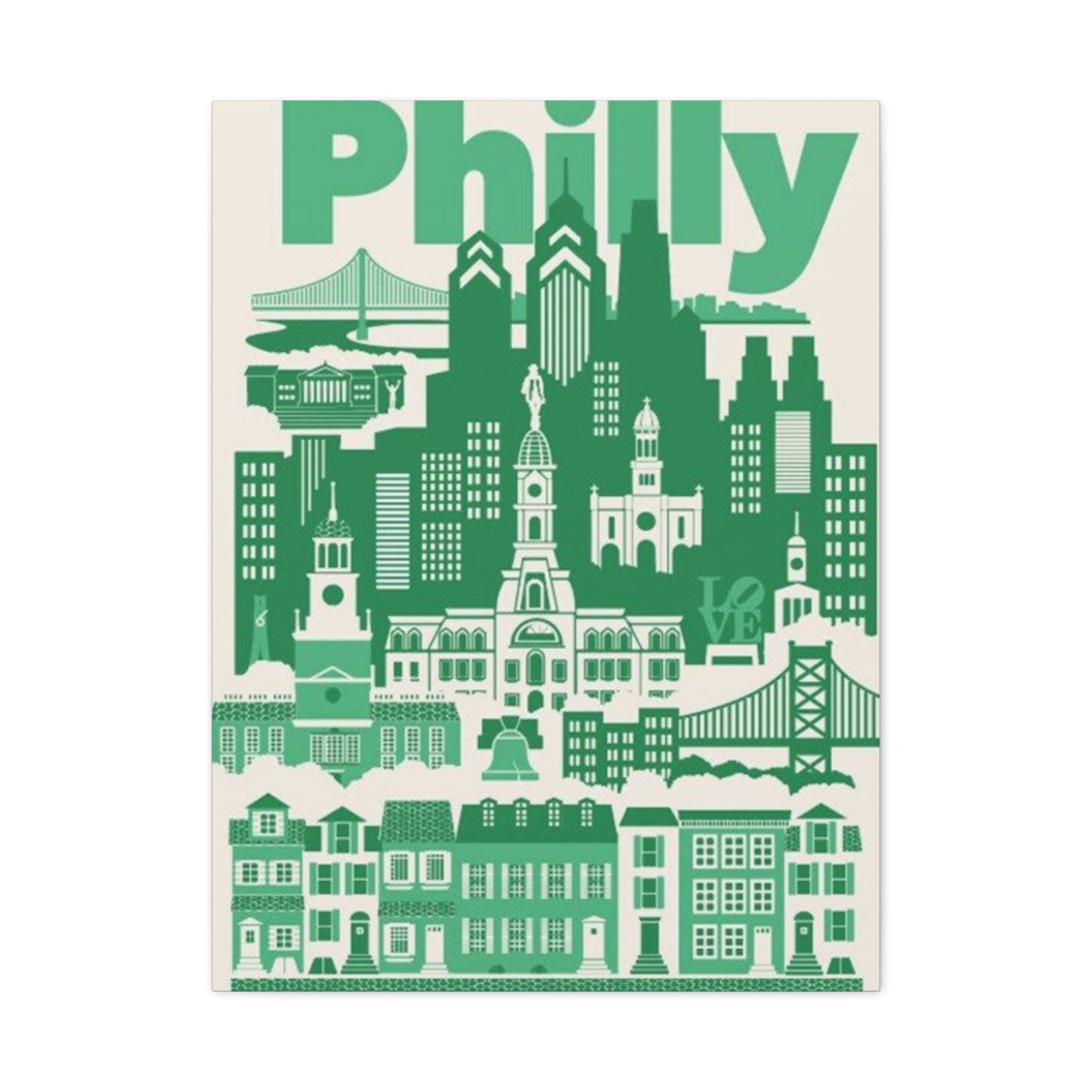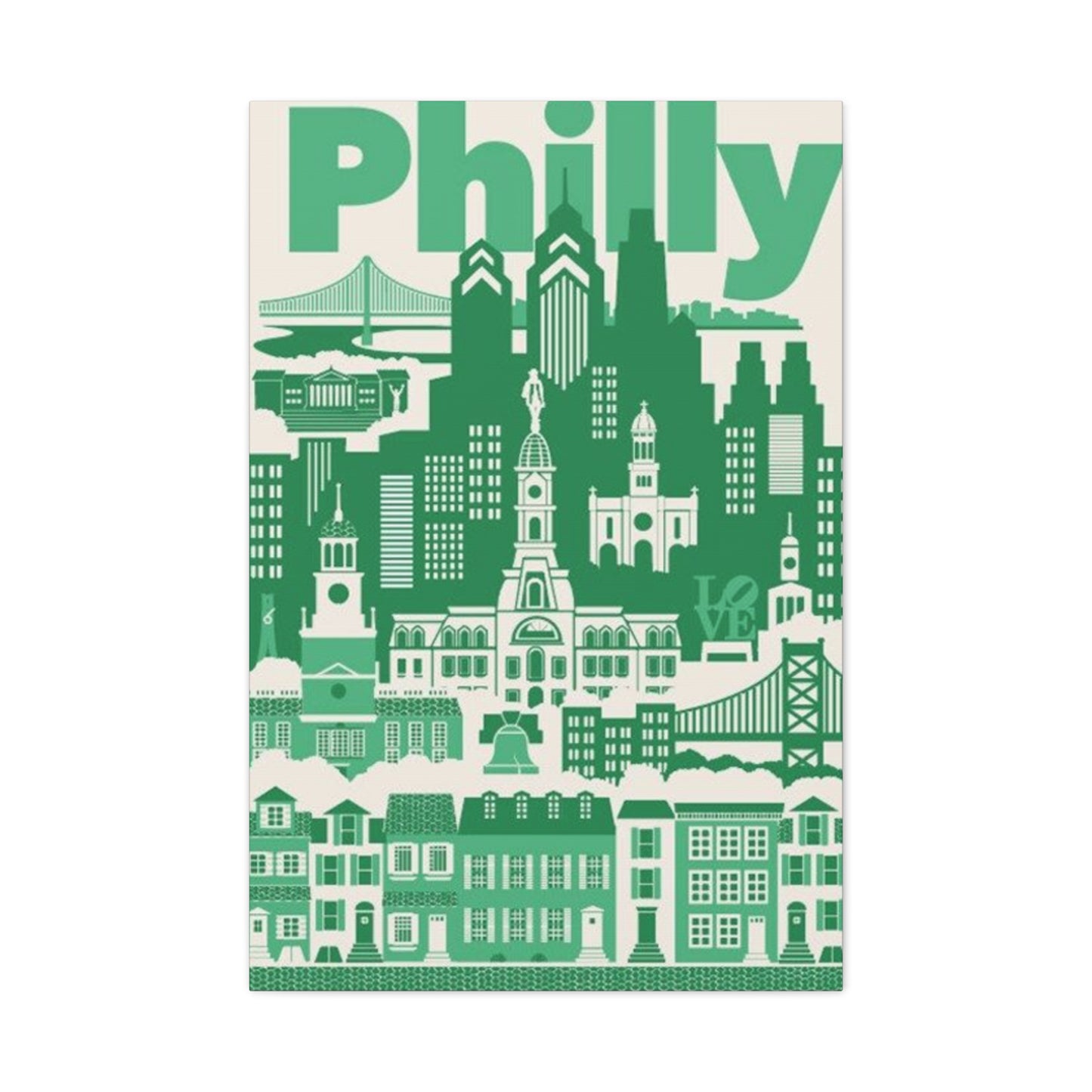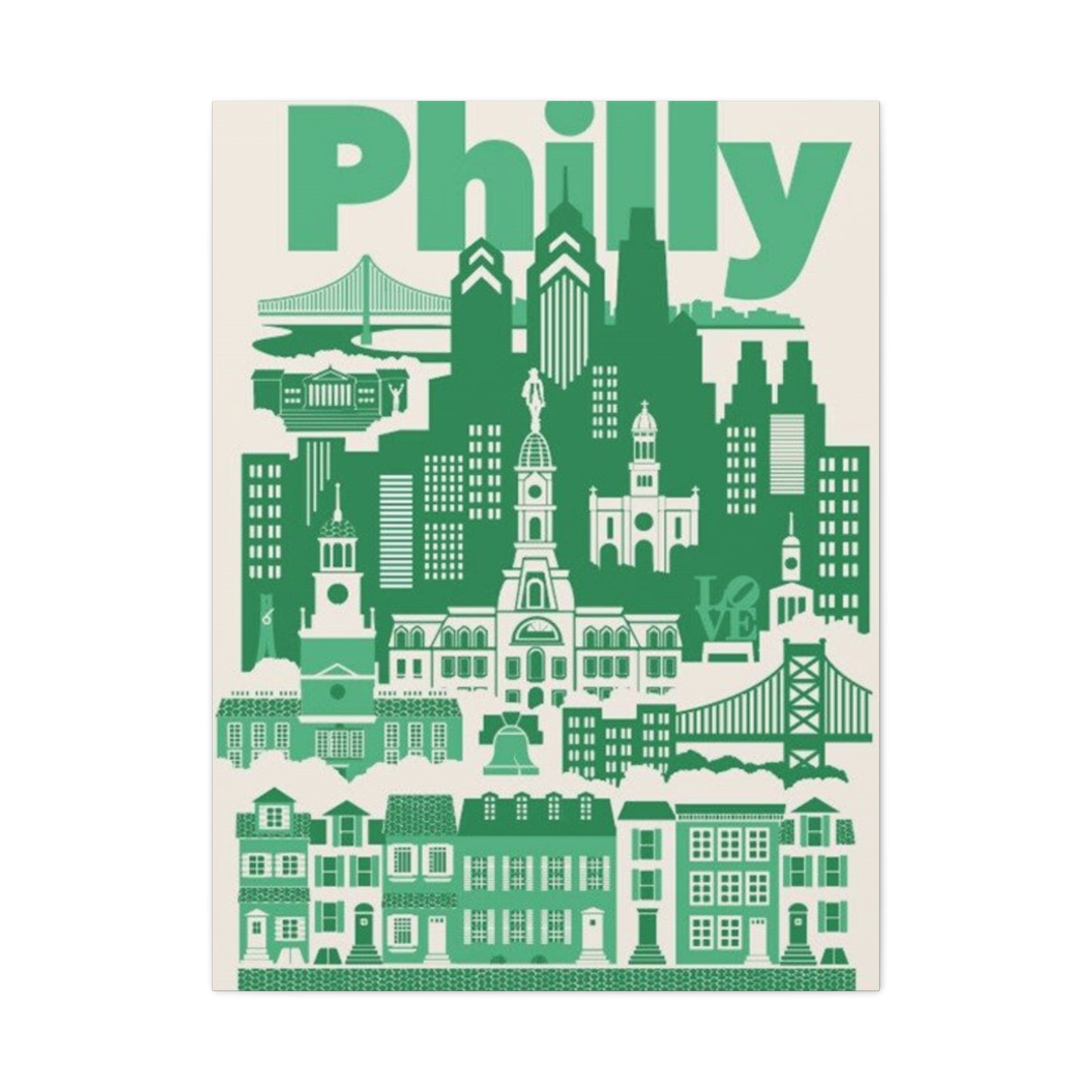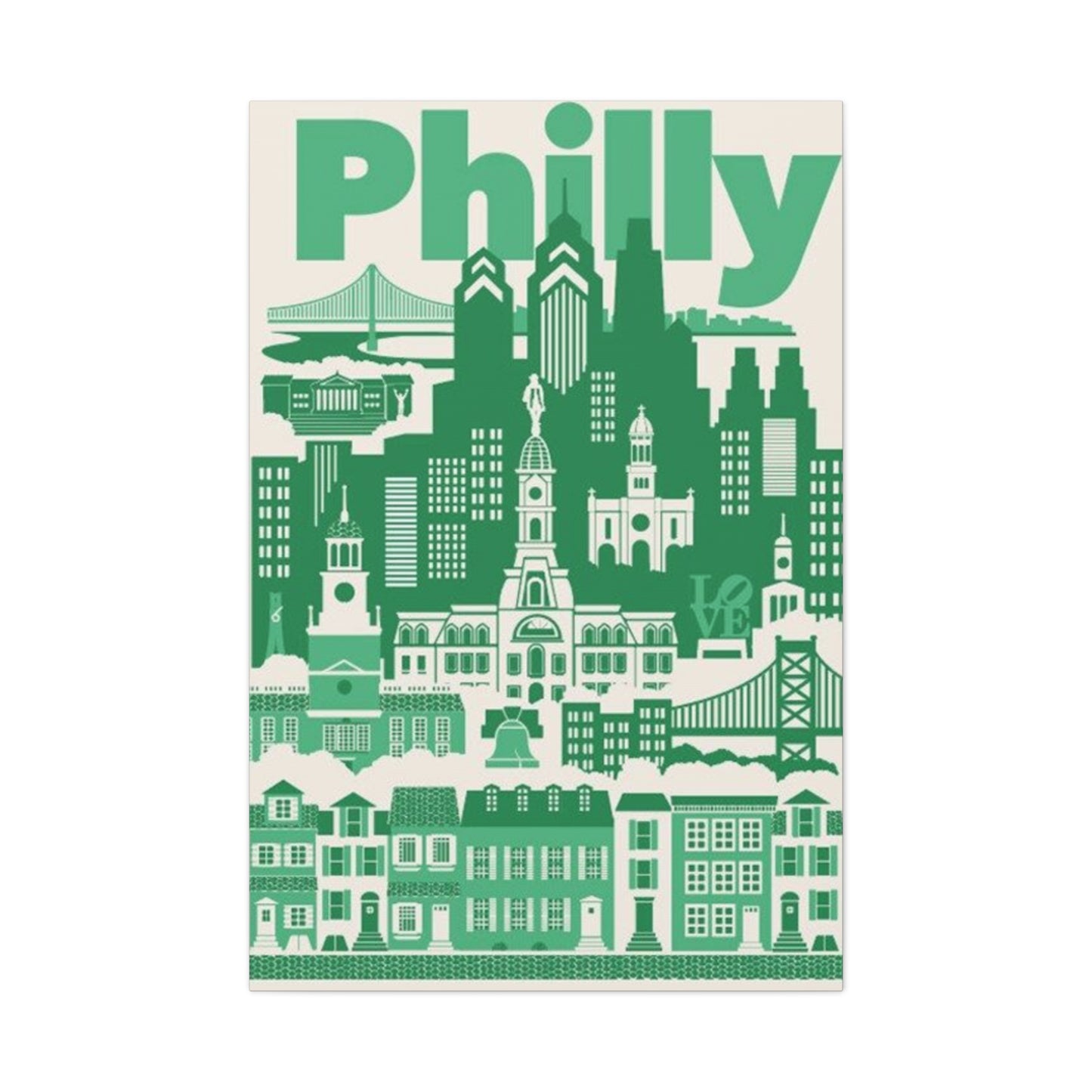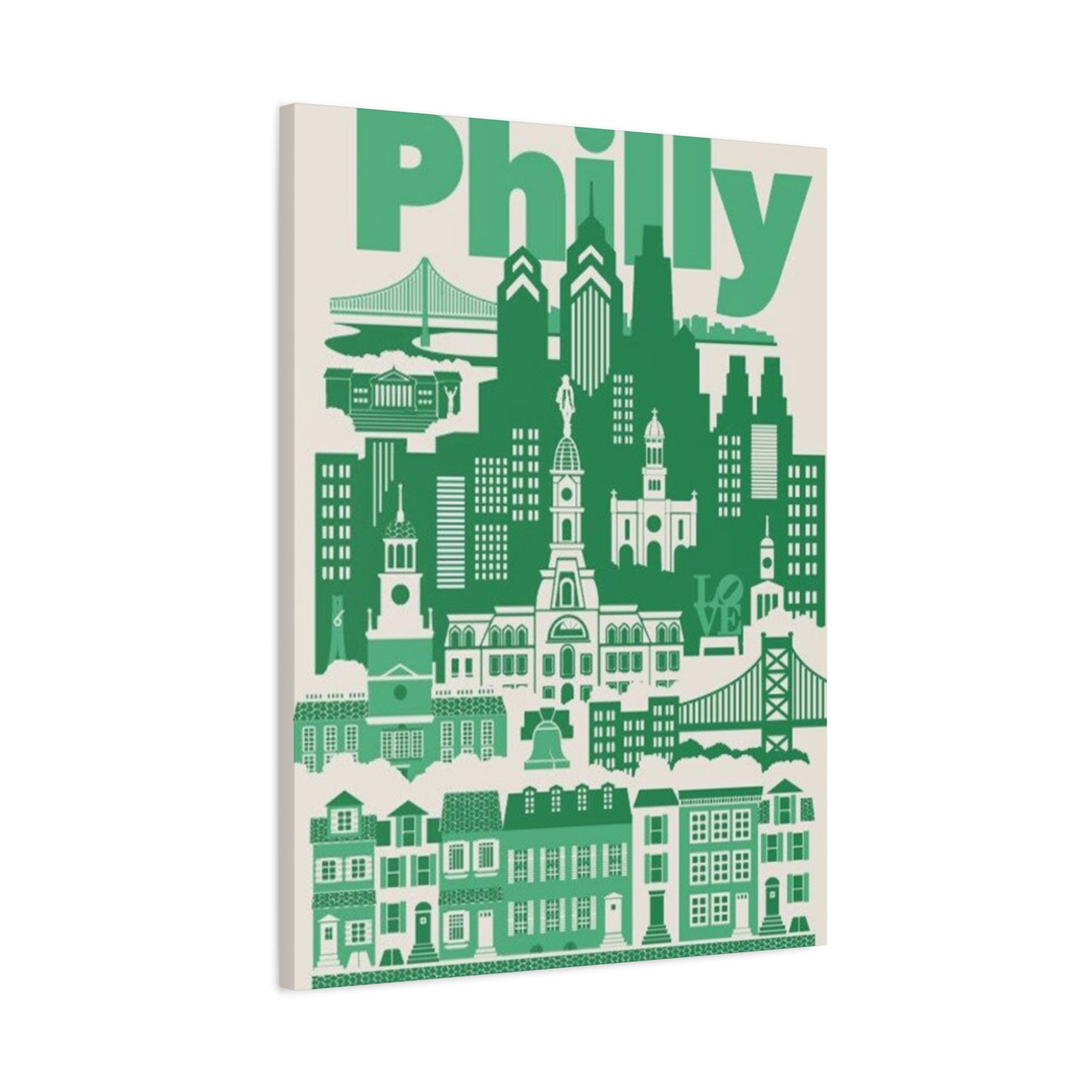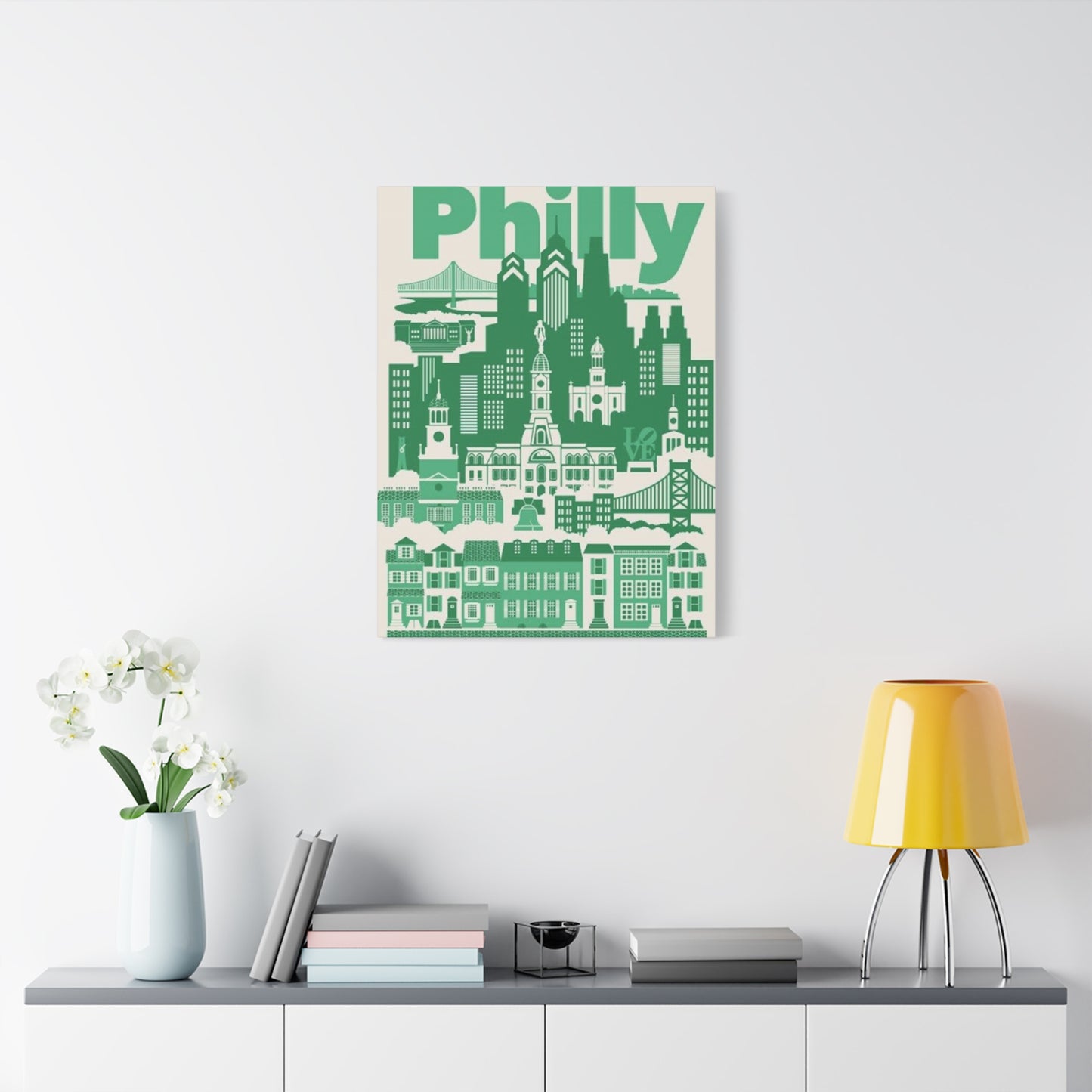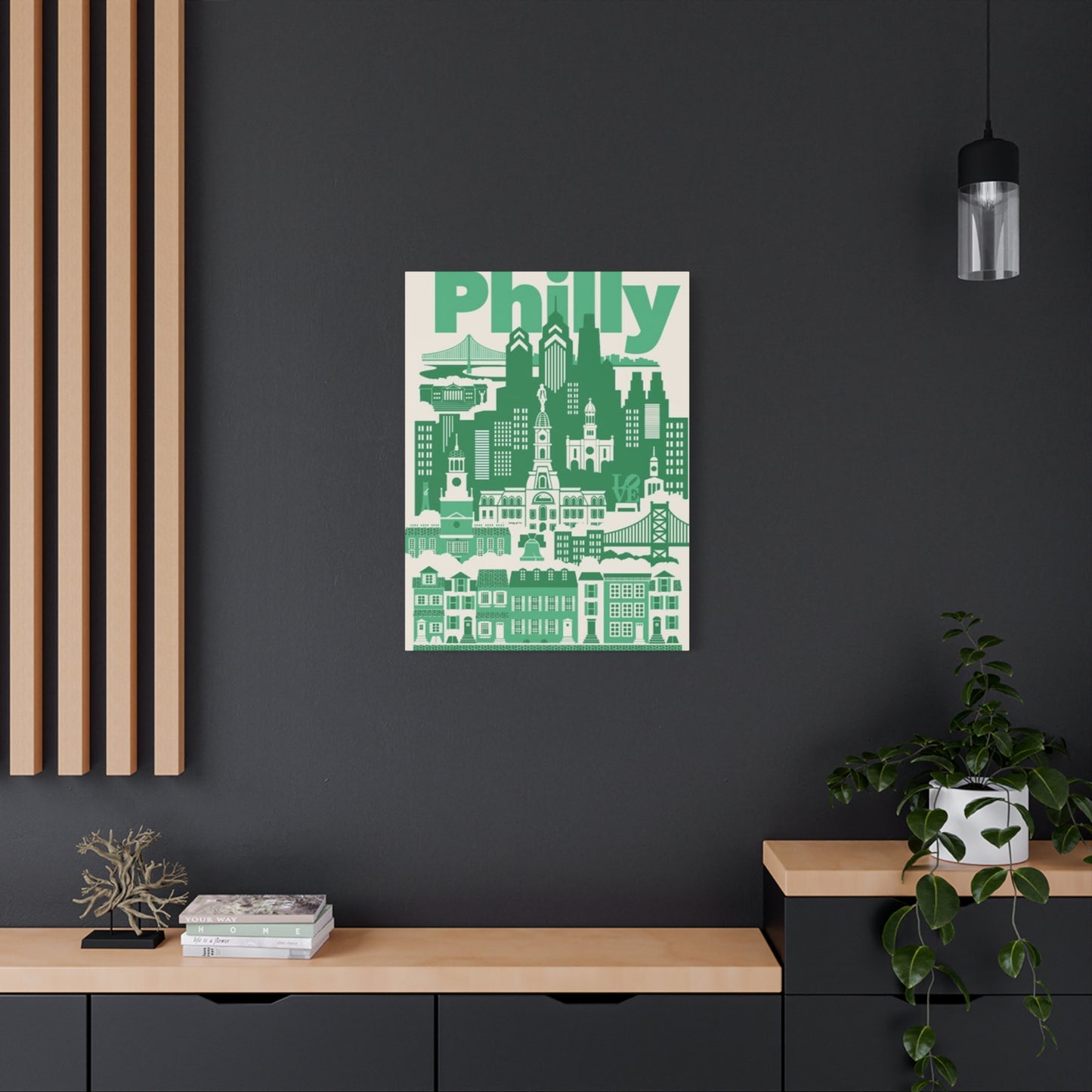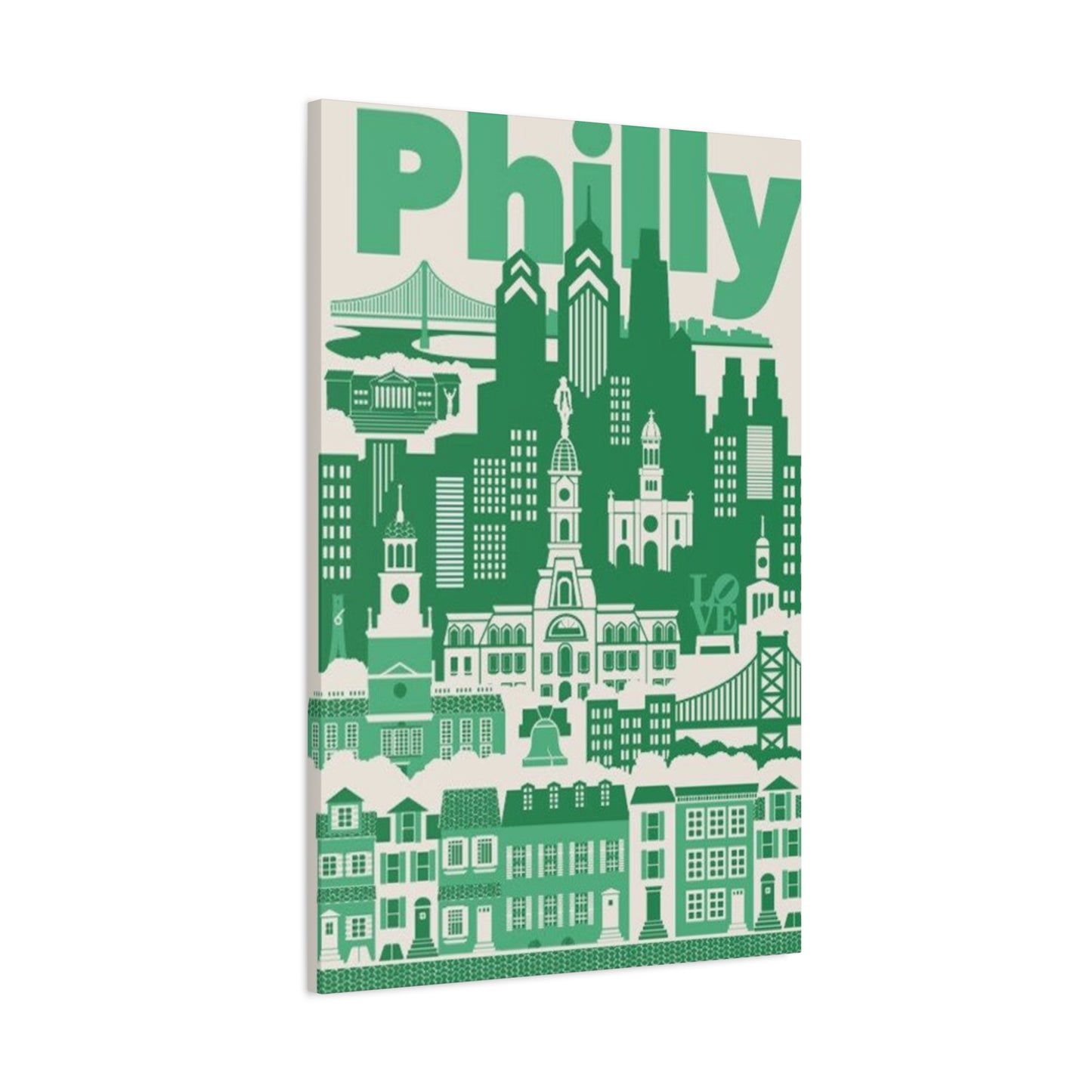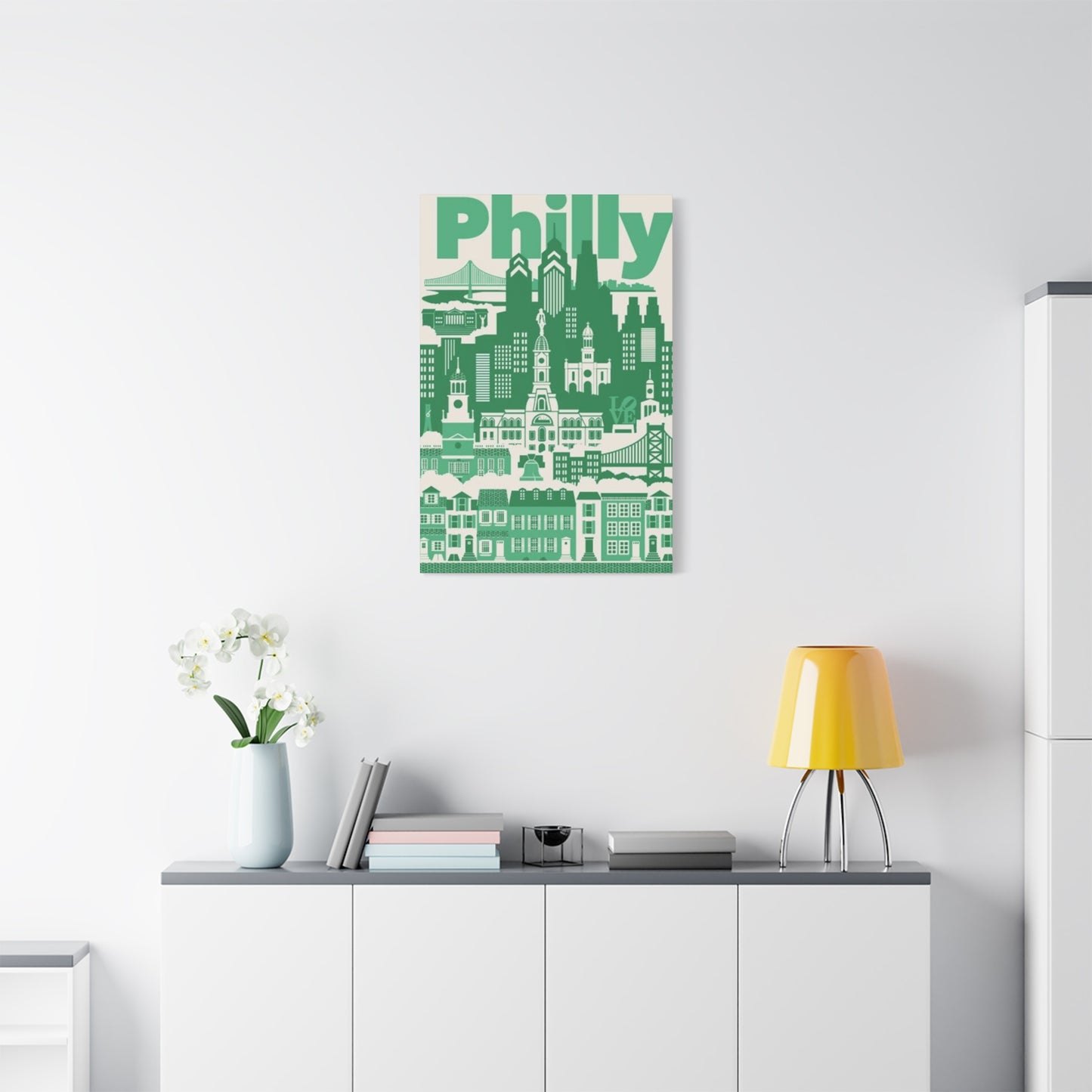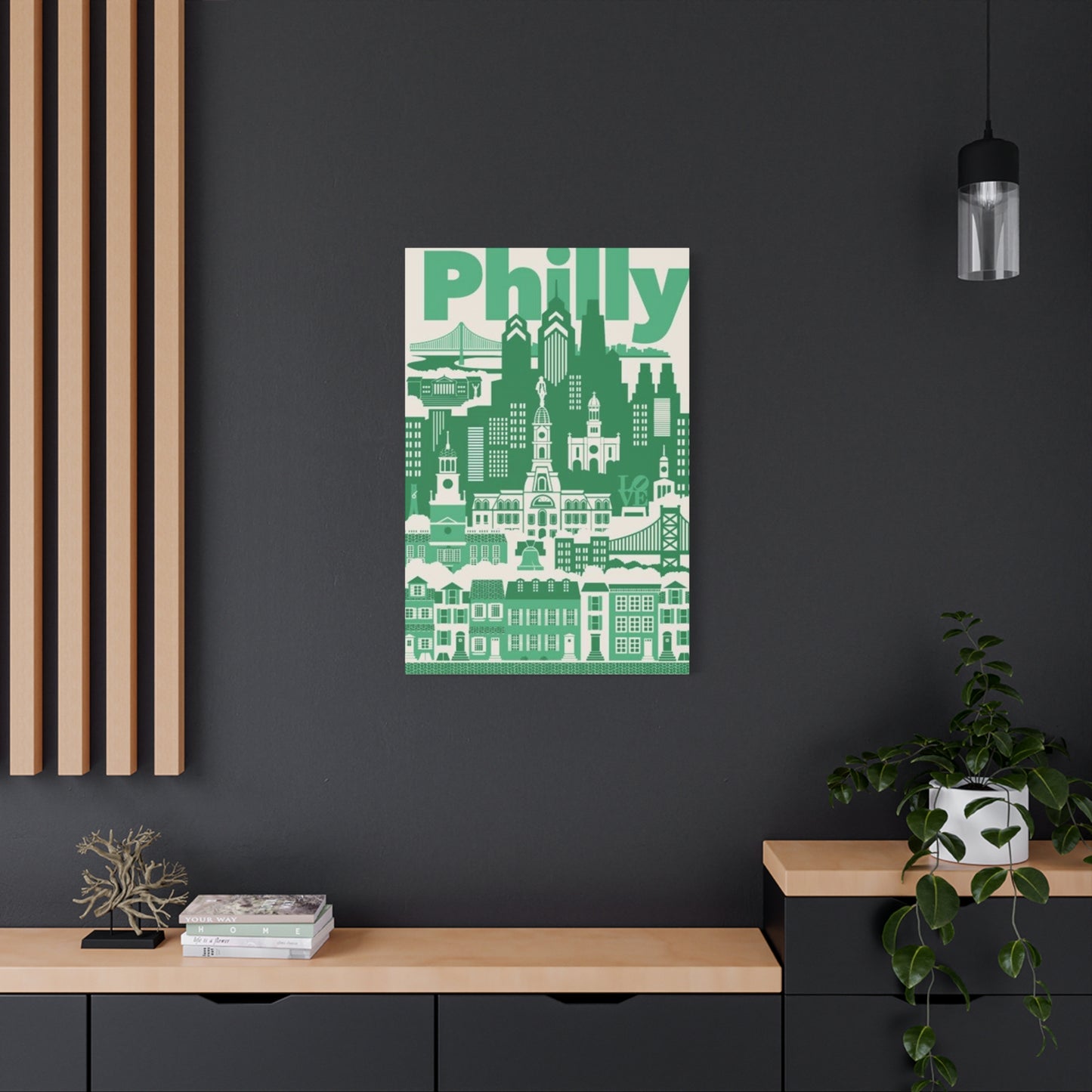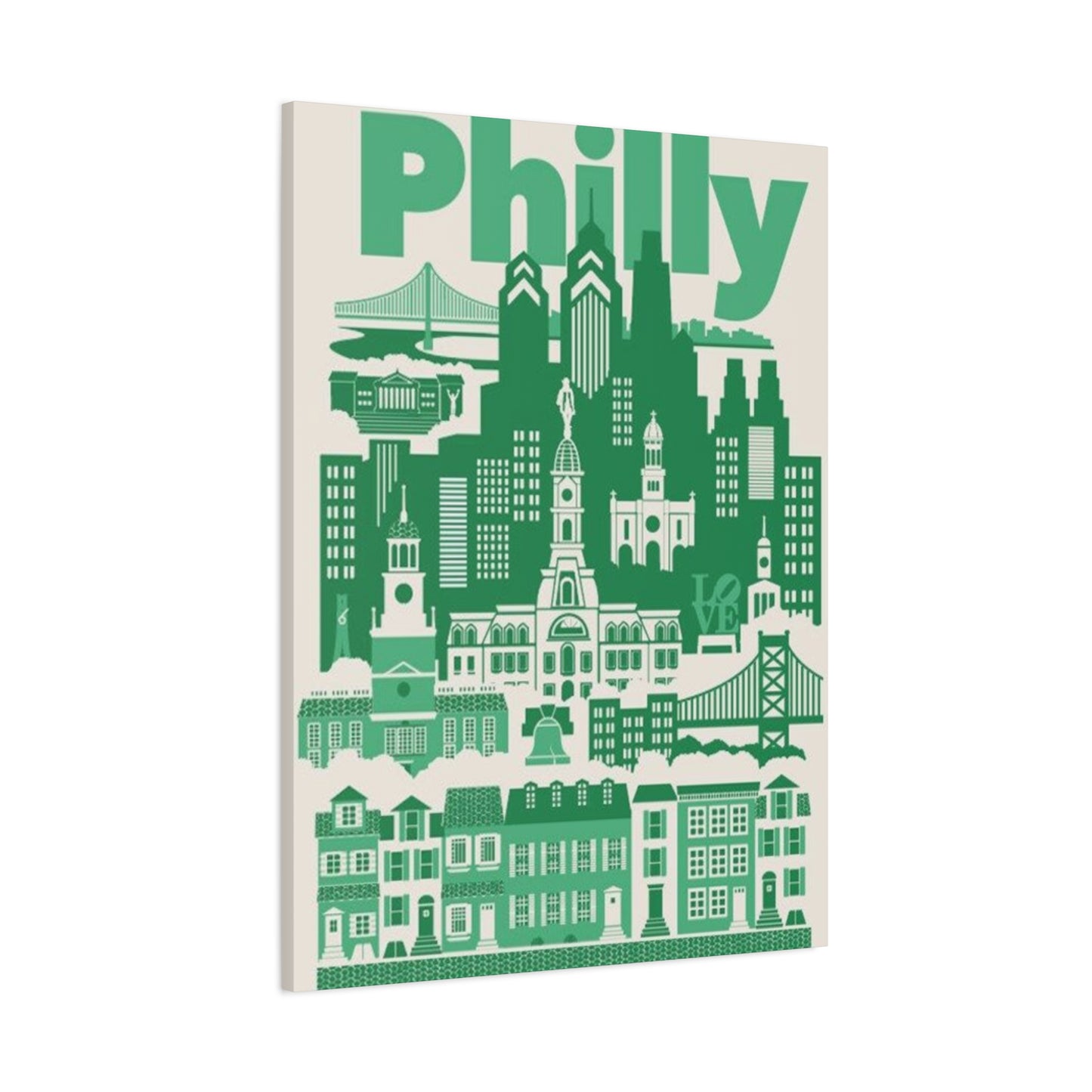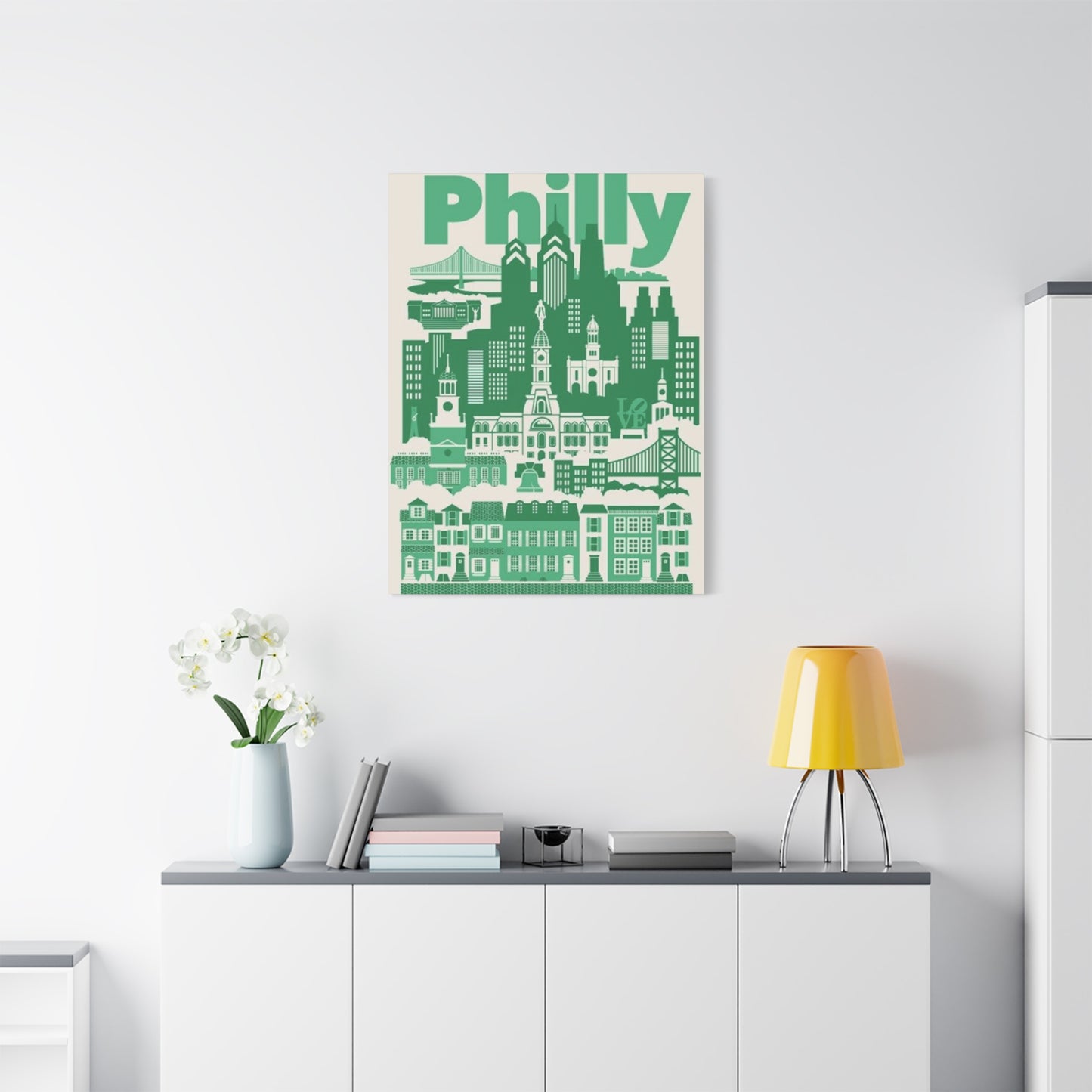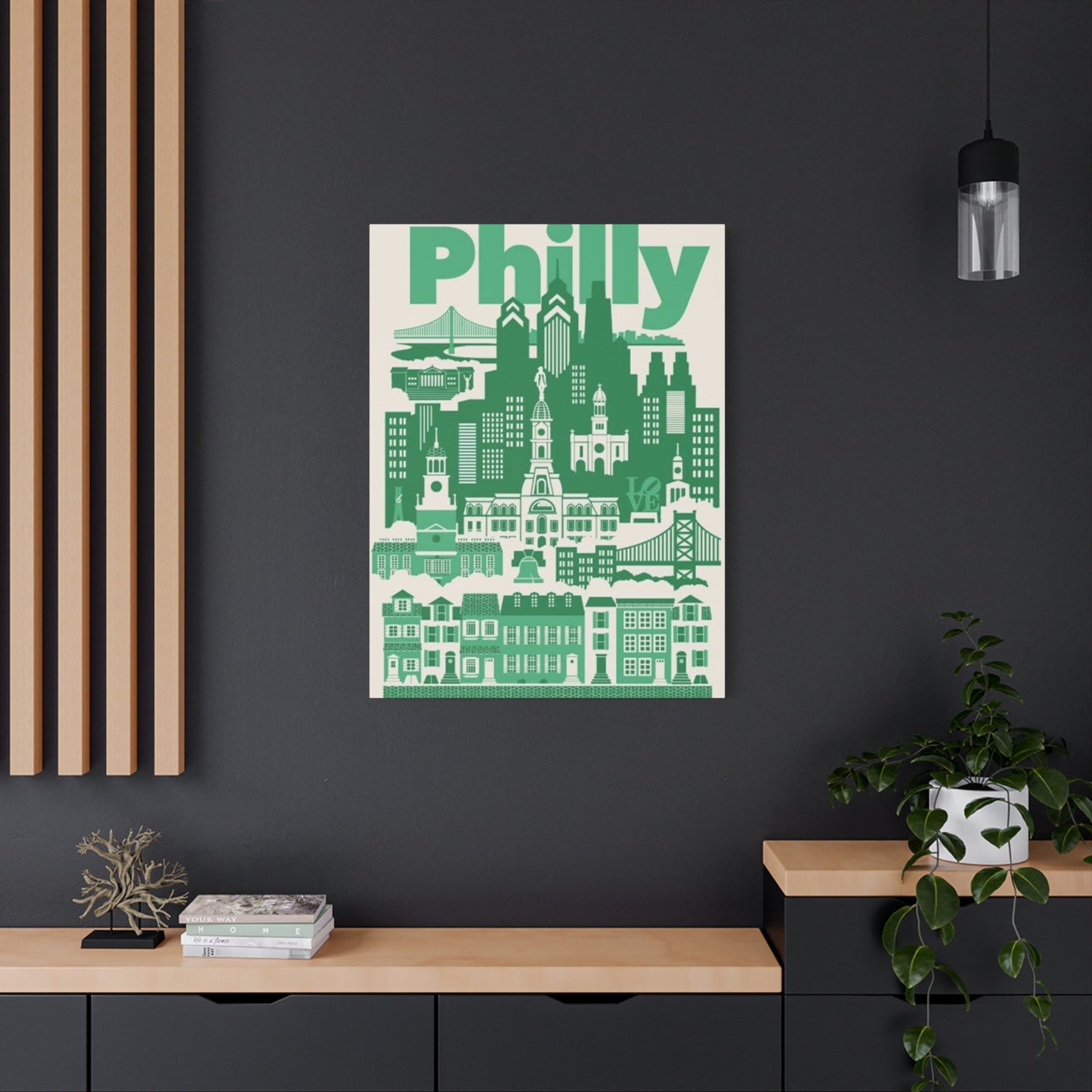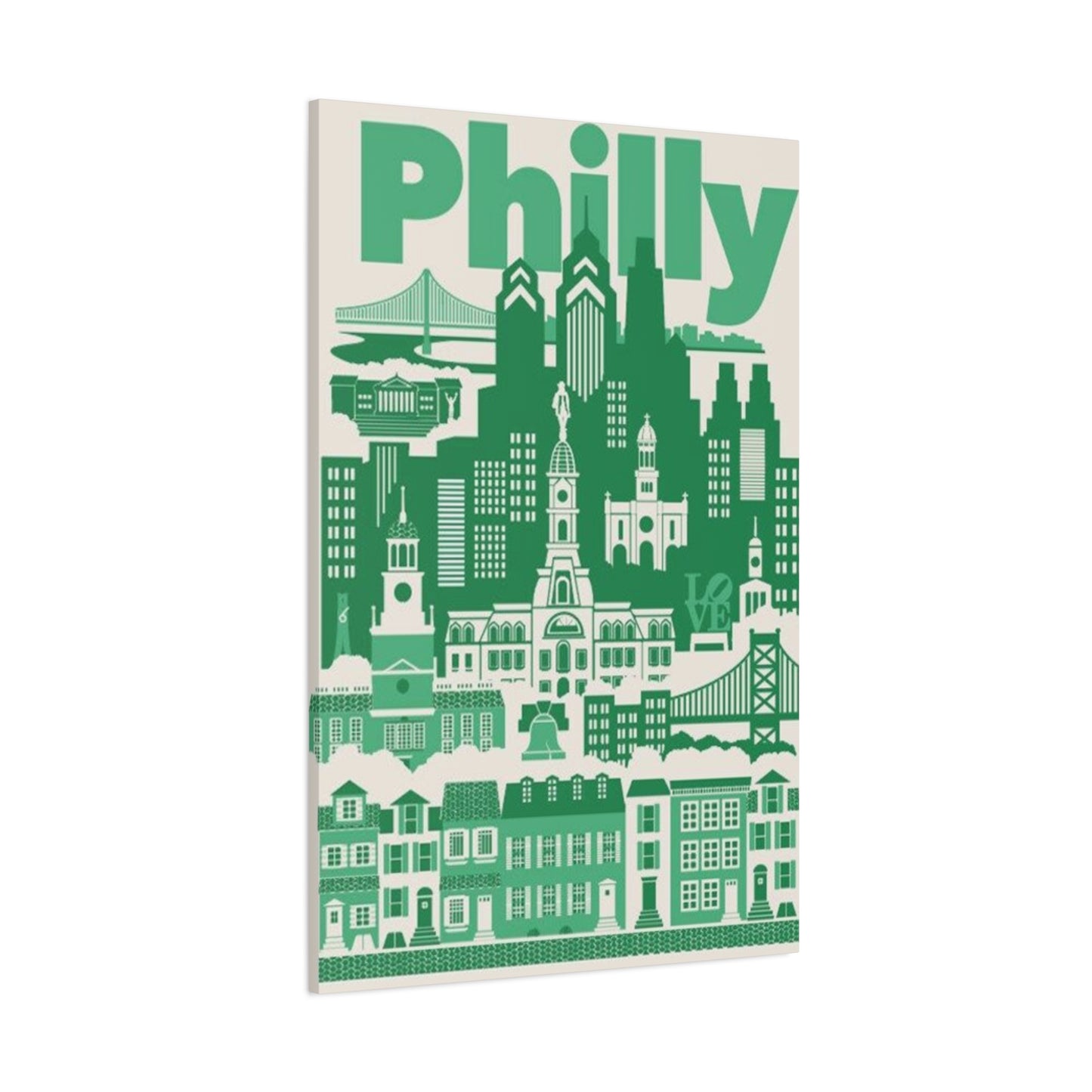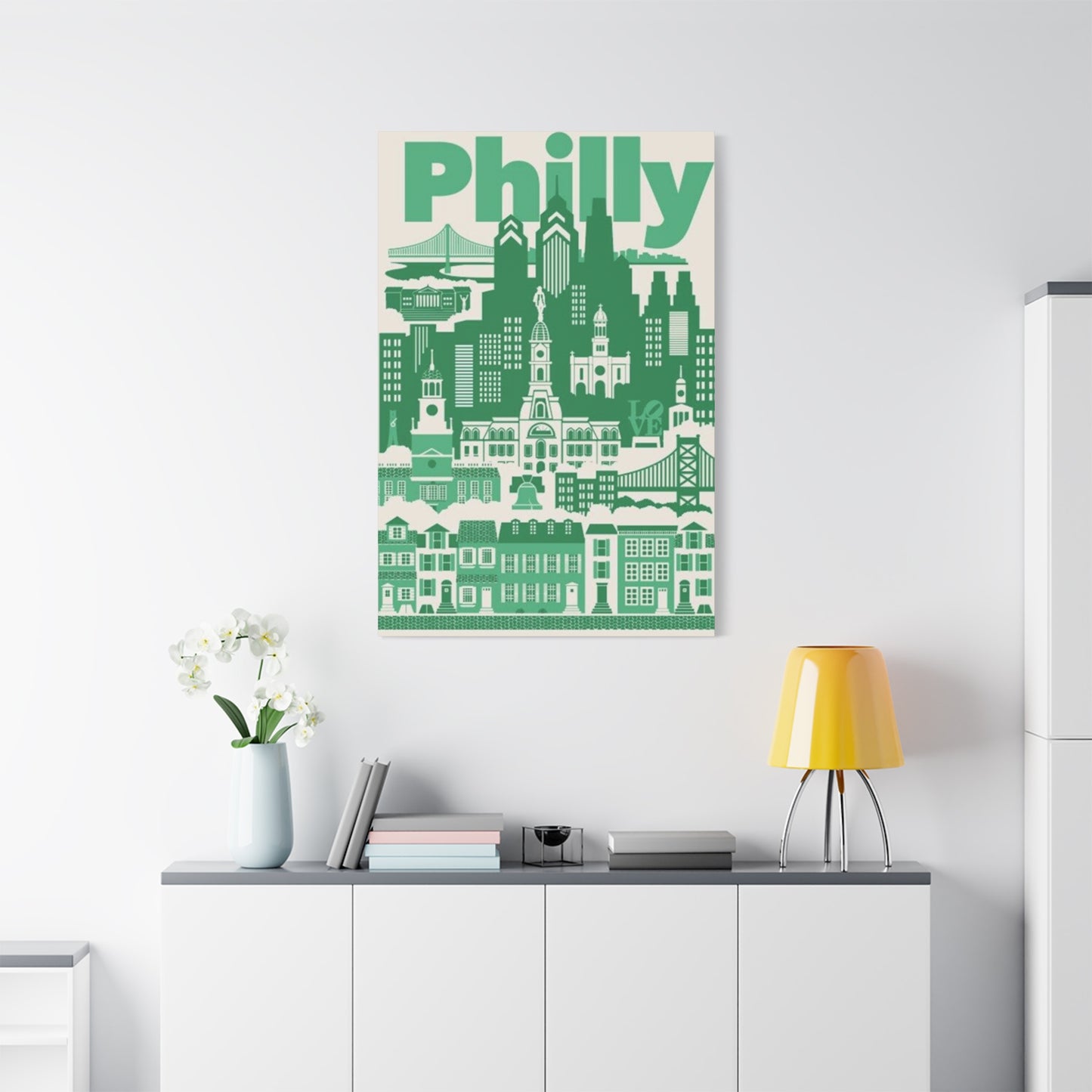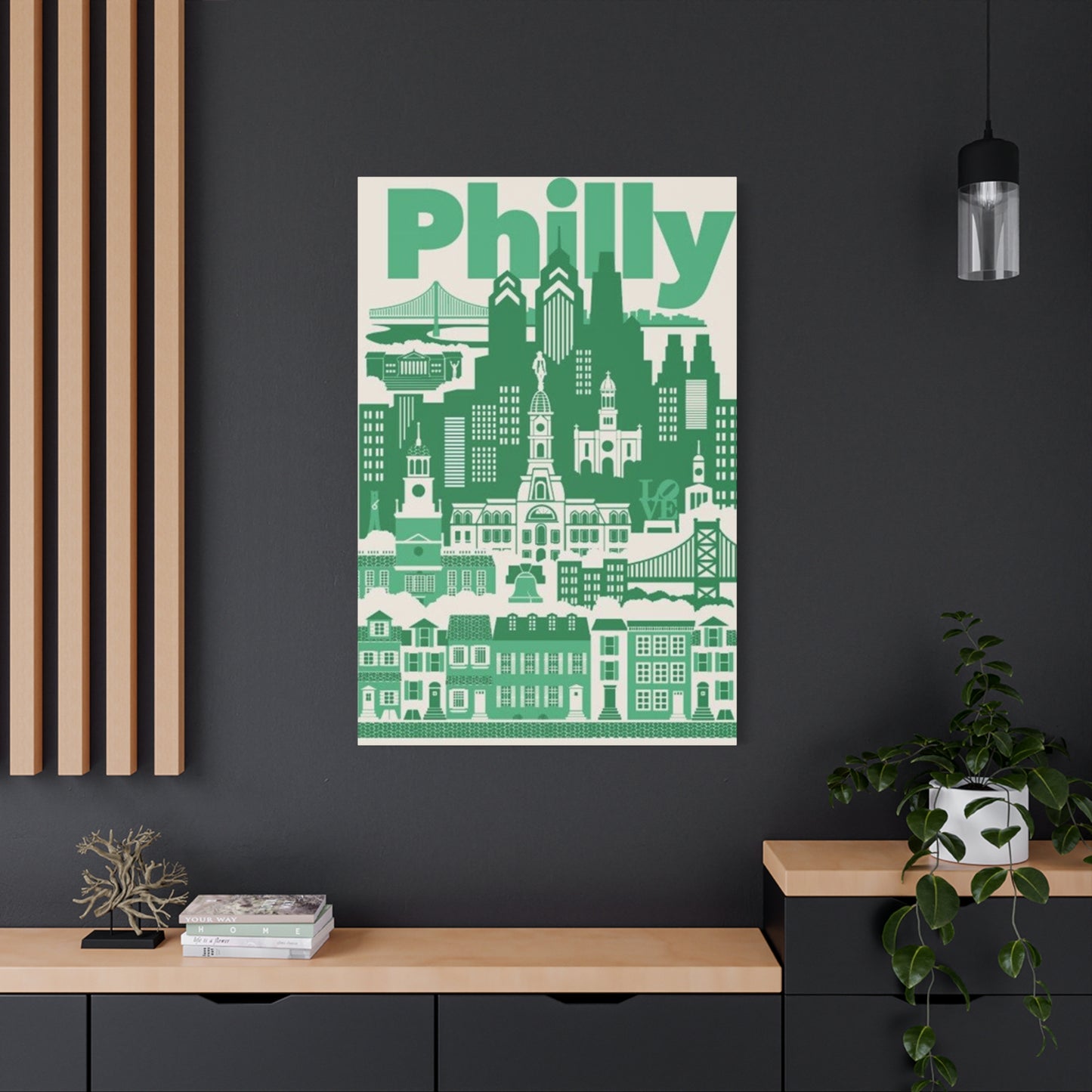Bring the City to Life: Green Philadelphia Wall Art for Urban Vibes
Philadelphia's architectural beauty and natural landscapes have inspired countless artists to create stunning visual representations that capture the essence of the City of Brotherly Love. When it comes to decorating homes and offices, green-themed Philly wall art offers a perfect blend of urban sophistication and natural tranquility. These artistic pieces not only celebrate Philadelphia's iconic landmarks but also incorporate the calming and refreshing qualities of green tones that can transform any living environment.
The appeal of Philadelphia-themed artwork lies in its ability to connect residents and visitors with the city's rich history, vibrant culture, and distinctive character. From the historic cobblestone streets of Old City to the modern skyscrapers that define the contemporary skyline, Philadelphia offers an endless array of visual inspiration. When these iconic elements are presented through the lens of green color palettes, they create artwork that is both culturally significant and aesthetically pleasing.
Green-themed Philly wall art serves multiple purposes in contemporary home decoration. First, it provides a strong connection to place, allowing residents to celebrate their city pride while maintaining a sophisticated aesthetic. Second, green tones are scientifically proven to promote relaxation, reduce stress, and create a sense of harmony in living environments. Third, these pieces often serve as excellent conversation starters, inviting guests to discuss both the artistic merits of the work and their own connections to Philadelphia.
The versatility of green-themed Philadelphia artwork makes it suitable for various decorating styles and room configurations. Whether you prefer minimalist modern aesthetics, traditional colonial charm, or eclectic contemporary designs, there are green Philly art options that can complement and enhance your existing decor. The key is understanding how different shades of green work with various design elements and how Philadelphia's iconic imagery can be incorporated seamlessly into your personal style.
Philly Landmarks Rendered in Verdant Tones
Philadelphia's most recognizable landmarks take on new life when interpreted through green color schemes. The Liberty Bell, Independence Hall, the Philadelphia Museum of Art, and the iconic LOVE sculpture become even more captivating when artists reimagine them with emerald, forest, sage, and mint green accents. These landmark-focused pieces offer viewers a fresh perspective on familiar sights while maintaining the historical and cultural significance that makes these locations so meaningful to Philadelphia residents and visitors.
Artists who specialize in green-themed landmark artwork often employ various techniques to achieve their distinctive looks. Some use watercolor washes that blend different shades of green to create dreamy, impressionistic interpretations of famous buildings and monuments. Others prefer bold, graphic approaches that use solid blocks of green color to create striking geometric representations of Philadelphia's architectural elements. Still others combine photography with digital art techniques, overlaying green filters or adding green elements to create unique hybrid pieces that blur the line between realistic documentation and artistic interpretation.
The Liberty Bell, perhaps Philadelphia's most famous symbol, becomes particularly striking when rendered in green tones. Artists might depict the bell surrounded by lush foliage, suggesting its connection to freedom and growth, or use various shades of green to highlight different aspects of its famous crack and bronze surface. These interpretations often emphasize themes of renewal, hope, and the enduring nature of American democratic ideals.
Independence Hall, where both the Declaration of Independence and the Constitution were signed, offers rich opportunities for green-themed artistic interpretation. Artists might focus on the building's Georgian architecture, using green tones to highlight its brick facade and distinctive bell tower, or they might create more abstract representations that use green geometric shapes to suggest the building's historical importance and architectural beauty.
The Philadelphia Museum of Art, famous for its neoclassical architecture and the "Rocky Steps," provides another excellent subject for green-themed artwork. Artists often emphasize the museum's imposing columns and grand entrance, using green tones to create dramatic shadows and highlights that emphasize the building's monumental character. Some pieces focus on the famous bronze statue of Rocky Balboa, incorporating green elements to suggest the character's connection to the city's working-class spirit and determination.
City Hall, with its elaborate Second Empire architecture and iconic William Penn statue, offers tremendous potential for green-themed artistic interpretation. The building's intricate details and towering presence make it an ideal subject for artwork that uses various green shades to highlight different architectural elements. Artists might use deep forest greens to emphasize the building's shadows and recesses, while using lighter mint or sage greens to highlight decorative elements and the famous statue that crowns the structure.
The Ben Franklin Bridge, one of Philadelphia's most photographed landmarks, becomes even more dramatic when interpreted through green color palettes. Artists often use the bridge's suspension cables and Art Deco towers as compositional elements, incorporating green tones that suggest the Delaware River's natural environment while celebrating the bridge's engineering achievement. These pieces often capture both the bridge's functional beauty and its symbolic role as a connection between Philadelphia and New Jersey.
Boathouse Row, the iconic collection of Victorian boathouses along the Schuylkill River, provides endless inspiration for green-themed artwork. The buildings' distinctive architecture, combined with their waterfront location and the natural beauty of the surrounding area, makes them perfect subjects for pieces that celebrate both Philadelphia's recreational culture and its relationship with nature. Artists often use green tones to suggest the river's flowing water, the surrounding trees and parkland, and the peaceful atmosphere that makes Boathouse Row such a beloved Philadelphia destination.
Emerald Urban Skylines and Cityscapes
Philadelphia's evolving skyline offers contemporary artists numerous opportunities to create green-themed urban artwork that captures the city's modern energy while incorporating natural color elements. These skyline prints often feature the city's most distinctive buildings, including One Liberty Place, the Comcast Center, and the newest additions to the Philadelphia skyline, all rendered in various shades of green that create cohesive and calming visual compositions.
The technique of creating green-toned cityscape art involves careful consideration of how different buildings and architectural elements can be represented using various green hues. Lighter shades might be used to represent glass surfaces catching sunlight, while darker greens can emphasize shadows, depth, and the solid mass of concrete and steel structures. This approach creates artwork that maintains the recognizable silhouette of Philadelphia's skyline while transforming it into something more abstract and aesthetically unified.
Many green cityscape prints focus on specific times of day when natural lighting conditions enhance the green color palette. Dawn and dusk scenes, for example, often feature soft green tones that complement the natural lighting conditions during these transitional periods. Artists might also create pieces that imagine Philadelphia's skyline during different seasons, using green tones to suggest spring growth, summer abundance, or the early green shoots of plants emerging in late winter.
The integration of natural elements into urban skyline artwork creates pieces that celebrate Philadelphia's commitment to green practices and environmental sustainability. Artists might include representations of the city's green roofs, urban gardens, or tree-lined streets, using these elements to create visual bridges between the built environment and the natural world. These pieces often appeal to viewers who appreciate both urban sophistication and environmental consciousness.
Philadelphia's relationship with its two major rivers, the Delaware and the Schuylkill, provides additional opportunities for green-themed cityscape art. Artists often incorporate flowing water elements using blue-green tones that suggest the rivers' presence while maintaining the overall green color scheme. These water elements help create dynamic compositions that suggest movement and life within the urban environment.
The city's numerous bridges, including the Betsy Ross Bridge, the Tacony-Palmyra Bridge, and the Walt Whitman Bridge, often serve as important compositional elements in green-themed skyline artwork. These structures can be rendered in various green tones that help integrate them visually with the surrounding cityscape while celebrating their functional and aesthetic contributions to Philadelphia's urban landscape.
Seasonal variations in green cityscape artwork allow artists to explore how Philadelphia's appearance changes throughout the year. Spring pieces might feature bright, fresh green tones that suggest new growth and renewal, while summer artwork could use deeper, more saturated greens that evoke abundance and maturity. Fall pieces might incorporate yellow-greens and olive tones that bridge the gap between summer's full green and autumn's changing colors.
The perspective chosen for green cityscape artwork significantly impacts the final piece's emotional resonance and visual appeal. Bird's-eye views that show the city from above allow artists to include more green elements, such as parks, tree-lined streets, and green roofs, creating compositions that emphasize Philadelphia's integration of natural and built environments. Ground-level perspectives might focus more on specific architectural details and the human scale of the city, using green tones to create intimate and approachable urban scenes.
Natural Philadelphia: Parks and Green Environments
Philadelphia's extensive park system provides rich source material for artists creating green-themed wall art that celebrates the city's natural beauty and environmental assets. Fairmount Park, one of the largest urban park systems in the United States, offers countless opportunities for artwork that captures the interplay between urban development and preserved natural areas. These pieces often focus on the park's rolling hills, mature trees, historic mansions, and recreational facilities, all rendered in various green tones that emphasize the area's role as an urban oasis.
Rittenhouse Square, one of Philadelphia's most beloved urban parks, serves as inspiration for artwork that combines formal landscape design with natural beauty. Artists often focus on the park's mature trees, carefully maintained gardens, and central fountain, using green tones to create pieces that capture the park's role as a peaceful retreat within the busy Center City environment. These works often emphasize the park's social function as a gathering place for residents and visitors, incorporating human figures and activities that show how people interact with urban green areas.
The Delaware River waterfront, with its recently developed parks and recreational areas, provides opportunities for artwork that celebrates Philadelphia's renewed relationship with its riverfront. Artists might focus on the landscaped areas along the river, the bicycle and walking paths, or the various recreational facilities that make this area a popular destination for outdoor activities. Green-themed artwork featuring the waterfront often emphasizes themes of renewal, recreation, and the city's evolving relationship with its natural boundaries.
Philadelphia's numerous neighborhood parks and squares offer intimate settings for green-themed artwork that captures the city's community-oriented character. Washington Square, with its historic significance and mature trees, provides material for pieces that combine historical reverence with natural beauty. Logan Square, with its distinctive fountain and formal landscaping, offers opportunities for artwork that celebrates both human creativity and natural elements.
The Schuylkill River Trail, which runs for miles through Philadelphia and its suburbs, serves as inspiration for artwork that captures the experience of moving through urban and natural environments. Artists might create pieces that show different sections of the trail, from the industrial areas near Center City to the more natural sections that pass through Fairmount Park. These pieces often emphasize the trail's role in connecting different neighborhoods and providing access to both recreational opportunities and natural beauty.
Urban gardens and community green initiatives throughout Philadelphia provide material for artwork that celebrates grassroots environmental efforts and community building. Artists might focus on rooftop gardens, community vegetable plots, or the various greening initiatives that transform vacant lots into productive green areas. These pieces often emphasize themes of community cooperation, environmental stewardship, and the transformation of urban environments through collective action.
The Philadelphia Zoo, located in Fairmount Park, offers unique opportunities for green-themed artwork that combines natural elements with educational and conservation themes. Artists might create pieces that show the zoo's landscaped areas, its commitment to conservation, or the relationship between urban environments and wildlife preservation. These works often appeal to families and individuals interested in both environmental issues and Philadelphia's educational and cultural institutions.
Street trees and urban forestry initiatives provide material for artwork that shows how natural elements are integrated throughout Philadelphia's neighborhoods. Artists might create pieces that celebrate the city's tree-lined streets, the seasonal changes that affect urban trees, or the various species that thrive in urban environments. These pieces often emphasize the importance of urban forestry in creating livable, attractive neighborhoods and the role that individual trees play in improving urban air quality and providing natural beauty.
Contemporary Abstract Interpretations
Modern abstract artists working with Philadelphia themes often create green-toned pieces that capture the essence and energy of the city without relying on literal representations. These abstract interpretations allow viewers to connect emotionally with Philadelphia's character while enjoying artwork that functions primarily as aesthetic enhancement rather than documentary representation. Abstract green Philly art often focuses on color relationships, geometric forms, and compositional elements that suggest urban energy, natural growth, or the dynamic relationship between built and natural environments.
Geometric abstraction using green color palettes can represent Philadelphia's grid street system, the angular relationships between buildings, or the formal elements of the city's planned squares and parks. Artists might use various shades of green in geometric compositions that suggest the order and structure of urban planning while maintaining the organic qualities associated with natural growth and environmental harmony. These pieces often work well in contemporary settings where clean lines and simplified forms are preferred.
Expressionistic abstract pieces might use green paint in ways that suggest movement, energy, or emotional responses to urban life. These works often feature bold brushstrokes, dynamic compositions, and color relationships that evoke feelings rather than depicting specific places or objects. Green-themed expressionistic Philadelphia art might capture the excitement of city life, the tranquility of park environments, or the complex emotions associated with urban living.
Color field paintings using various green tones can create meditative, atmospheric pieces that suggest Philadelphia's natural and urban environments without depicting them literally. These works often focus on subtle color relationships and the emotional impact of different green hues, creating pieces that function as visual environments rather than representations of specific places. Such artwork often works well in settings where a calming, contemplative atmosphere is desired.
Mixed media abstract pieces might combine painted elements with collage materials, photographs, or found objects that reference Philadelphia while maintaining primarily abstract compositions. Artists might incorporate maps, newspaper clippings, or other printed materials related to Philadelphia, using green paint or other media to integrate these elements into cohesive artistic statements. These pieces often appeal to viewers who enjoy discovering hidden references and layers of meaning within abstract compositions.
Minimalist abstract interpretations often use simple geometric forms and limited color palettes to suggest Philadelphia themes with maximum visual impact and minimal compositional elements. A piece might consist of simple green shapes that suggest the city's squares, the flow of its rivers, or the basic relationships between built and natural environments. These works often function well in settings where simplicity and visual clarity are prioritized.
Digital abstract art allows for precise color control and complex layering effects that can create sophisticated green-themed pieces referencing Philadelphia. Digital artists might combine photographic elements with painted or drawn elements, using computer software to achieve color relationships and compositional effects that would be difficult to create using traditional media. These pieces often appeal to viewers who appreciate contemporary technology and its creative applications.
Sculptural elements incorporated into abstract wall pieces can create three-dimensional works that use green materials or green-painted elements to suggest Philadelphia themes. These might include relief sculptures that use various materials painted in green tones, or pieces that combine flat painted areas with sculptural elements that cast shadows or create textural variety. Such works often function as focal points in rooms where dramatic visual impact is desired.
Green Color Psychology in Urban Art
The psychology of green color in urban-themed artwork plays a crucial role in how these pieces affect viewers and the environments in which they are displayed. Green is universally associated with nature, growth, renewal, and tranquility, making it an excellent choice for artwork intended to create calming, balanced environments. When applied to urban themes like Philadelphia cityscapes and landmarks, green tones can help bridge the gap between the energy of city life and the restorative qualities of natural environments.
Different shades of green produce different psychological effects, and understanding these variations helps in selecting artwork that achieves desired emotional and aesthetic goals. Light, bright greens often evoke feelings of freshness, energy, and optimism, making them excellent choices for artwork intended to energize environments or suggest growth and positive change. These lighter green tones work particularly well in Philadelphia artwork that celebrates the city's renewal efforts, park developments, or emerging neighborhoods.
Deeper, more saturated green tones tend to create feelings of stability, sophistication, and calm contemplation. Forest greens, hunter greens, and similar dark tones can make Philadelphia artwork feel more grounded and substantial, appropriate for settings where a sense of permanence and reliability is desired. These darker greens often work well in artwork featuring Philadelphia's historic landmarks or established neighborhoods.
Blue-green tones, such as teal and aqua, combine the calming properties of blue with the growth-oriented associations of green, creating colors that feel both soothing and dynamic. These tones work particularly well in Philadelphia artwork that incorporates water elements, such as pieces featuring the Delaware or Schuylkill rivers, or artwork that celebrates the city's waterfront developments.
Yellow-green combinations create colors that feel energetic and optimistic while maintaining green's natural associations. Lime greens, chartreuse, and similar bright yellow-greens can make Philadelphia artwork feel contemporary and vibrant, appropriate for pieces that celebrate the city's dynamic culture or innovative developments. These colors often work well in modern settings where bold color choices are appreciated.
The interaction between green tones and other colors in Philadelphia artwork significantly impacts the overall psychological effect of the pieces. Green combined with blue creates cool, calming compositions that suggest water, sky, and peaceful natural environments. Green with gray can create sophisticated, urban-feeling pieces that maintain natural associations while acknowledging the concrete and steel reality of city environments.
Green combined with warm colors like orange or red creates dynamic tension that can make artwork feel more energetic and engaging. These combinations often work well in Philadelphia artwork that celebrates the city's vibrant culture, diverse neighborhoods, or dynamic street life. The contrast between warm and cool colors helps create visual interest while maintaining green's natural associations.
The amount of green versus other colors in a composition also affects its psychological impact. Pieces dominated by green tones tend to feel more restful and natural, while pieces that use green as an accent color might feel more dynamic and urban. Understanding these relationships helps in selecting Philadelphia artwork that creates the desired atmospheric effects in specific environments.
Philadelphia's Natural Areas in Artistic Focus
The Wissahickon Valley, a pristine natural area within Philadelphia's borders, provides inspiration for green-themed artwork that captures some of the most beautiful natural scenery available in an urban setting. Artists working with Wissahickon themes often focus on the area's creek, mature forest, and hiking trails, creating pieces that celebrate this unique natural resource and its importance to Philadelphia residents seeking outdoor recreation and natural beauty within the city limits.
The natural areas along the Delaware River, including various parks and preserved areas, offer opportunities for artwork that combines river themes with natural landscape elements. These pieces might focus on wetland areas, native plant communities, or the various bird and wildlife species that inhabit these riverfront natural areas. Green-themed artwork featuring these locations often emphasizes environmental conservation and the importance of preserving natural areas within urban environments.
Philadelphia's urban forests, including both formal parks and informal natural areas, provide material for artwork that shows how nature persists and thrives within urban environments. Artists might focus on mature trees in neighborhoods, natural areas that have developed in vacant lots, or the various plant communities that establish themselves in urban settings. These pieces often celebrate nature's resilience and the ways that natural processes continue to operate within city environments.
The city's various creek and stream corridors, many of which have been restored or preserved as natural areas, offer opportunities for artwork that celebrates water ecology and habitat preservation. Tacony Creek, Cobbs Creek, and other waterways provide settings for green-themed art that focuses on riparian environments and the plant and animal communities that depend on these water resources.
Community gardens throughout Philadelphia provide material for artwork that celebrates grassroots environmental efforts and community-based food production. These pieces might focus on the seasonal cycles of vegetable gardens, the community cooperation involved in maintaining shared garden areas, or the transformation of urban lots into productive green areas. Such artwork often appeals to viewers interested in sustainable living and community building.
Green roofs and urban sustainability initiatives throughout Philadelphia offer contemporary themes for artwork that celebrates environmental innovation and green building practices. Artists might create pieces that show rooftop gardens, green infrastructure projects, or the various ways that Philadelphia is incorporating natural elements into urban development and redevelopment projects.
The Philadelphia region's native plant communities provide opportunities for artwork that focuses on botanical accuracy while celebrating the specific plant species that naturally occur in the local environment. These pieces might feature native trees, wildflowers, or other plant species, often incorporating educational elements that help viewers learn about local ecology while enjoying aesthetically pleasing artwork.
Urban wildlife themes allow artists to create green-themed pieces that celebrate the various animal species that live within Philadelphia's city limits. These might include birds, small mammals, or other wildlife species, often shown in their urban habitats and emphasizing the ways that natural communities adapt to and thrive within urban environments.
Minimalist Green Philadelphia Aesthetics
Minimalist approaches to green-themed Philadelphia artwork emphasize simplicity, clean lines, and carefully chosen elements that suggest the city's character without overwhelming compositions with excessive detail. These pieces often use limited color palettes dominated by various green tones, simple geometric forms, and plenty of negative area to create maximum visual impact with minimum compositional elements.
Simplified landmark representations might reduce Philadelphia's most recognizable buildings and monuments to their essential geometric forms, using green tones to create unified compositions that maintain recognizable silhouettes while eliminating unnecessary detail. The Liberty Bell might become a simple curved form in sage green, while Independence Hall could be represented by basic rectangular shapes that suggest its Georgian architecture without depicting every architectural detail.
Typography-based minimalist pieces might incorporate Philadelphia-related text or quotes using green colors and simple, clean typefaces. These pieces often work well in contemporary settings where text-based art is appreciated, and they can incorporate historical quotes, neighborhood names, or other Philadelphia-related language elements while maintaining minimalist aesthetic principles.
Geometric interpretations of Philadelphia's street grid might use simple green lines or shapes to suggest the city's planned layout and organized structure. These pieces often appeal to viewers who appreciate both urban planning concepts and minimalist design principles, creating artwork that celebrates rational organization while maintaining visual simplicity.
Single-color variations using only different shades and tones of green can create sophisticated pieces that rely on subtle color relationships rather than dramatic contrasts or complex compositions. These monochromatic pieces often feel calming and unified, appropriate for settings where visual tranquility is prioritized over dramatic impact.
Negative area, or white area, plays a crucial role in minimalist green Philadelphia artwork, providing visual rest and helping to emphasize the importance of the green elements that are included. Effective use of negative area can make simple green shapes or lines feel more significant and impactful than they might in more complex compositions.
Linear elements, such as simple green lines that suggest the Delaware or Schuylkill rivers, Philadelphia's major streets, or the outlines of important buildings, can create minimalist pieces that communicate Philadelphia themes while maintaining visual simplicity. These linear approaches often work well in contemporary settings where clean, uncluttered aesthetics are preferred.
Photographic minimalism might involve photographs of Philadelphia subjects that are simplified through cropping, filtering, or other techniques that reduce visual complexity while maintaining recognizable Philadelphia content. These pieces often use green filters or processing techniques that unify diverse photographic elements while preserving the realistic foundation that makes the Philadelphia connection clear to viewers.
Professional Framing and Display Techniques
The presentation of green-themed Philadelphia artwork significantly impacts its visual effectiveness and longevity. Professional framing techniques can enhance the artwork's impact while protecting it from environmental damage and ensuring that it maintains its appearance over time. The choice of matting, frames, and display methods should complement the artwork while considering the specific requirements of different media and the environmental conditions where the pieces will be displayed.
Matting choices for green Philadelphia artwork should consider how different colors and textures will interact with the green tones in the pieces. Neutral matting colors like white, cream, or light gray often work well with green artwork, providing clean borders that don't compete with the green elements while enhancing their visual impact. Colored matting can be effective but requires careful consideration to avoid clashing with the green tones or overwhelming the artwork itself.
Frame selection should consider both the artwork's style and the environment where it will be displayed. Contemporary green Philadelphia artwork often works well with simple, clean frames that don't distract from the artistic content. Traditional wooden frames might be appropriate for more classical interpretations, while metal frames often complement modern or industrial themes.
Glass selection involves choosing between regular glass, anti-reflective glass, and UV-protective glass based on the specific needs of the artwork and display environment. UV-protective glass is particularly important for artwork that will be exposed to direct sunlight, as it helps prevent fading and color changes that can affect the appearance of green tones over time.
Lighting considerations are crucial for green artwork, as different light sources can significantly alter the appearance of green colors. Natural daylight generally provides the most accurate color representation, but artificial lighting should be chosen carefully to maintain the intended color relationships. LED lighting with high color rendering indexes often provides good results for indoor artwork display.
Wall preparation and hanging techniques should ensure that artwork is securely mounted and properly positioned for optimal viewing. The height at which artwork is hung, its relationship to furniture and other room elements, and the viewing distances involved all affect how the artwork is experienced by viewers.
Grouping multiple pieces requires careful attention to spacing, alignment, and visual relationships between different artworks. Green Philadelphia pieces can be effectively grouped with other Philadelphia-themed artwork or with complementary pieces that share similar color palettes or aesthetic approaches.
Environmental considerations include factors like humidity, temperature fluctuations, and air quality that can affect artwork over time. Proper environmental controls help ensure that green colors remain stable and that the overall appearance of the artwork is preserved for years of enjoyment.
Color Harmony and Green Palette Coordination
Creating effective color harmony in green-themed Philadelphia artwork involves understanding how different green tones work together and with other colors to create cohesive, aesthetically pleasing compositions. The principles of color theory provide guidance for selecting and combining green hues that enhance rather than compete with each other, resulting in artwork that feels balanced and visually satisfying.
Monochromatic green schemes use only green hues, relying on variations in saturation, brightness, and warmth to create visual interest and depth. These approaches can create sophisticated, calming pieces that feel unified and serene while still maintaining enough variation to avoid monotony. Philadelphia artwork using monochromatic green schemes might use forest green for shadow areas, sage green for mid-tones, and mint green for highlights.
Analogous color schemes incorporate colors adjacent to green on the color wheel, such as blue-green and yellow-green combinations. These schemes often feel natural and harmonious because they reflect color relationships commonly found in natural environments. Philadelphia artwork using analogous schemes might combine the green of parks and trees with the blue-green of rivers and the yellow-green of spring foliage.
Complementary color schemes pair green with red or reddish colors to create dynamic contrast and visual energy. While these combinations require careful handling to avoid harsh contrasts, they can create striking Philadelphia artwork that celebrates both the city's natural elements and its brick architecture or other warm-colored urban features.
Triadic color schemes use green as one point of a triangle on the color wheel, often combining it with purple and orange or similar combinations. These schemes can create vibrant, energetic artwork but require careful balance to maintain harmony. Philadelphia artwork using triadic schemes might incorporate the green of parks, the purple of sunset skies, and the orange of brick buildings.
Temperature relationships between warm and cool greens can create depth and visual interest within predominantly green compositions. Cool blue-greens often recede visually, making them effective for background areas, while warm yellow-greens advance and work well for foreground elements or focal points.
Saturation levels affect how green colors interact within compositions. Highly saturated greens create bold, energetic effects, while muted or desaturated greens feel more sophisticated and subtle. Philadelphia artwork might combine both approaches, using saturated greens for emphasis and muted greens for supporting areas.
Value relationships, referring to the lightness or darkness of different green tones, help create depth, contrast, and visual hierarchy within compositions. Effective use of light, medium, and dark green values can make flat artwork appear three-dimensional and help guide viewers' attention to important compositional elements.
Seasonal Variations in Green Philadelphia Art
Philadelphia's distinct seasonal changes provide rich opportunities for artists to create green-themed artwork that captures the city's appearance and character throughout the year. Each season offers different green tones and natural elements that can be incorporated into Philadelphia artwork, creating pieces that celebrate specific times of year or the ongoing cycle of seasonal change that defines the city's relationship with the natural world.
Spring in Philadelphia brings fresh, bright green tones as trees leaf out, grass begins growing actively, and various spring flowers add color to parks and gardens. Artists working with spring themes often use light, yellow-green tones that suggest new growth and renewal, creating artwork that feels optimistic and energetic. Spring Philadelphia artwork might focus on blooming cherry trees in parks, the fresh green of new grass, or the various spring flowers that appear in urban gardens and natural areas.
Summer green tones in Philadelphia tend to be deeper, more saturated, and more blue-toned as vegetation reaches maturity and abundance. Summer Philadelphia artwork often uses rich forest greens, deep sage tones, and other sophisticated green hues that suggest the full development of the city's natural elements. These pieces might focus on the mature canopy of street trees, the lush landscaping in parks, or the various recreational activities that take place in green areas during the summer months.
Early autumn in Philadelphia often features yellow-green tones as leaves begin changing but haven't yet turned to full autumn colors. This transitional period offers opportunities for artwork that bridges summer's green abundance with autumn's colorful display. Artists might focus on the gradual change in tree colors, the late-season gardens, or the particular quality of light that characterizes early autumn in the city.
Winter green elements in Philadelphia include evergreen trees, winter-hardy plants, and the various ways that green elements persist even during the coldest months. Winter Philadelphia artwork might use muted blue-green tones that suggest the subdued but persistent natural elements that remain visible throughout the winter season. These pieces often feel contemplative and serene, celebrating the quiet beauty of winter urban landscapes.
Seasonal combinations allow artists to create pieces that show Philadelphia's changing character throughout the year, often using different green tones to represent different seasons within single compositions. These pieces might show the same location during different seasons or combine elements from various seasons to create artwork that celebrates the full cycle of seasonal change.
Weather-related green elements, such as the particular green tones that appear during rainy periods or the bright greens that follow snowmelt, provide additional opportunities for seasonal Philadelphia artwork. These weather-specific themes often appeal to viewers who have experienced these particular atmospheric conditions and can relate to the specific moments that inspire the artwork.
Holiday and seasonal celebrations in Philadelphia often incorporate green elements that can inspire themed artwork. Spring festivals, summer outdoor concerts, autumn harvest celebrations, and winter holiday displays all provide opportunities for green-themed artwork that combines Philadelphia's cultural life with seasonal natural elements.
Large-Format Green Canvas Presentations
Large-scale green-themed Philadelphia artwork creates dramatic focal points that can transform entire rooms and provide immersive visual experiences. These substantial pieces require careful planning in terms of composition, color relationships, and installation, but they offer opportunities for impact and presence that smaller artwork cannot achieve. Large format pieces work particularly well in contemporary settings with high ceilings and ample wall area.
Composition considerations for large-format pieces differ significantly from those for smaller artwork. Elements that work well in small compositions may feel overwhelming when scaled up, while details that are barely visible in small pieces may become major compositional elements when enlarged. Artists creating large green Philadelphia pieces must consider viewing distances, the relationship between detailed and simplified areas, and the overall visual rhythm of the composition.
Color intensity often needs adjustment for large-format pieces, as colors that appear subtle in small works may feel overwhelming when covering large wall areas. Green tones that work beautifully in small compositions may need to be muted or adjusted for large-scale applications. Artists must also consider how color relationships change when covering large areas and how the surrounding room colors will interact with extensive green artwork.
Installation requirements for large format pieces include considerations of wall structural support, hanging systems, and potential need for professional installation. Heavy pieces may require specialized mounting hardware, while extremely large pieces may need to be installed in sections or require special handling during transportation and positioning.
Viewing experience considerations include the fact that large pieces are often viewed from multiple distances and angles. Elements that work when viewing from across a room may not be effective when viewed from close up, and artists must create compositions that remain engaging at various viewing distances.
Lighting requirements for large format pieces often exceed those for smaller artwork. Large pieces may require multiple light sources to ensure even illumination, and the lighting design should consider both the artwork's requirements and the room's overall lighting needs. Track lighting, picture lights, or architectural lighting elements may be necessary.
Room proportion relationships become crucial when installing large format green Philadelphia artwork. The piece should enhance rather than overwhelm the room, and its scale should feel appropriate for the architectural context. Large pieces work best in rooms with high ceilings and sufficient viewing distance.
Maintenance considerations for large format pieces include regular cleaning, periodic condition assessment, and potential need for professional conservation services. Large pieces may be more susceptible to environmental factors and may require more careful attention to preservation than smaller works.
Creative DIY Approaches and Projects
Do-it-yourself approaches to creating green-themed Philadelphia artwork allow individuals to customize pieces according to their specific preferences, room requirements, and budget constraints. DIY projects can range from simple techniques accessible to beginners to more complex approaches that require advanced skills and specialized materials. These projects often provide personal satisfaction and create artwork that reflects individual connections to Philadelphia and personal aesthetic preferences.
Photography-based DIY projects might involve taking photographs of Philadelphia subjects and processing them to emphasize green tones or add green elements. Digital photo editing software allows for extensive color manipulation, enabling individuals to create green-toned versions of Philadelphia landmarks, cityscapes, or natural areas. These projects often combine the personal satisfaction of creating original photography with the technical skills involved in digital image processing.
Painting projects using various media can create original green Philadelphia artwork tailored to specific preferences and skill levels. Acrylic paints offer versatility and ease of use for beginners, while watercolors can create more subtle, atmospheric effects. Oil paints provide rich color possibilities but require more advanced techniques and longer drying times. Mixed media approaches might combine painting with collage elements, found materials, or digital printing.
Collage and mixed media projects can incorporate maps, photographs, printed materials, and other Philadelphia-related elements into green-themed compositions. These projects often allow for experimentation with different materials and techniques while creating artwork that includes multiple layers of Philadelphia references. Magazine cutouts, postcards, ticket stubs, and other memorabilia can be incorporated into personal Philadelphia artwork.
Digital art creation using computer software provides access to professional-level tools for creating sophisticated green Philadelphia artwork. Software like Photoshop, Illustrator, or free alternatives like GIMP allow for precise color control, complex layering effects, and integration of photographic and painted elements. Digital artwork can be printed on various materials and in different sizes to suit specific display requirements.
Printmaking techniques such as screen printing, block printing, or stenciling can create multiple copies of green Philadelphia designs. These techniques often work well for creating sets of related pieces or for producing artwork to share with others. Printmaking projects can range from simple single-color designs to complex multi-color compositions.
Fabric-based projects might involve creating wall hangings, quilts, or other textile artwork that incorporates green Philadelphia themes. These projects often appeal to individuals with sewing or fiber arts skills and can create artwork that adds textural variety to room environments. Fabric techniques might include appliqué, embroidery, fabric painting, or patchwork approaches.
Three-dimensional projects can create sculptural wall pieces that incorporate green elements while referencing Philadelphia themes. These might involve assemblage techniques using found materials, relief sculptures created from various materials, or mixed media pieces that combine flat and dimensional elements.
Gift Ideas and Green Philadelphia Art Collections
Green-themed Philadelphia artwork makes excellent gifts for various occasions and recipients, particularly for individuals with connections to Philadelphia or those who appreciate both urban themes and natural color palettes. Understanding different types of recipients and occasions helps in selecting appropriate pieces that will be appreciated and enjoyed over time.
Housewarming gifts benefit from artwork that helps new residents establish connections to their Philadelphia community while adding attractive decoration to their new homes. Green Philadelphia pieces work particularly well for housewarmings because green colors tend to be universally appealing and work with most decorating schemes. Pieces featuring neighborhood landmarks or general Philadelphia themes allow new residents to celebrate their location choice.
Conclusion
Green Philadelphia wall art is more than just a trend—it's a movement that breathes life, energy, and purpose into your space. By merging the vibrant urban culture of Philadelphia with nature-inspired elements, this style of artwork captures the true essence of a city that’s constantly evolving while staying rooted in history, community, and environmental awareness.
Philadelphia is a city known for its rich heritage, diverse neighborhoods, bold street art, and forward-thinking sustainability efforts. Green-themed art brings all of these elements together—celebrating the city’s architectural beauty, iconic landmarks, and dynamic energy while introducing calming, earthy tones and organic imagery. Whether it's a mural-inspired piece of Fairmount Park, a leafy interpretation of the skyline, or abstract greenery overlaid on urban textures, green Philadelphia wall art offers a refreshing, modern perspective.
Incorporating this type of artwork into your home or office doesn't just elevate your interior design—it also tells a story. It says you value urban culture and artistic expression, but also care about sustainability and balance. It’s ideal for city dwellers who want to soften the edge of industrial life, or for suburban and rural residents who want to bring a piece of Philadelphia’s soul into their space.
These artworks fit beautifully into a wide range of aesthetics, from modern minimalism to boho chic, industrial loft to eco-conscious interiors. Green hues bring a sense of tranquility, while the urban elements keep it grounded and energetic. Whether you're decorating a living room, a hallway, a studio, or a café, green Philadelphia wall art creates a focal point that sparks conversation and inspires connection to the city.
More than just decoration, these pieces contribute to a lifestyle—one that embraces culture, creativity, and conscious living. By selecting green-themed art that celebrates Philadelphia, you're supporting artists who are often inspired by the very streets they walk every day. You're bringing into your home a visual dialogue about growth, resilience, and renewal—qualities that Philadelphia embodies in every season.
Ultimately, green Philadelphia wall art helps transform any space into a thoughtful reflection of both urban grit and natural grace. It reminds us that even in the most bustling of cities, there’s always room for greenery, imagination, and harmony.

















